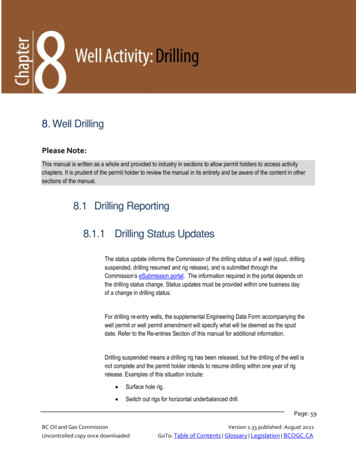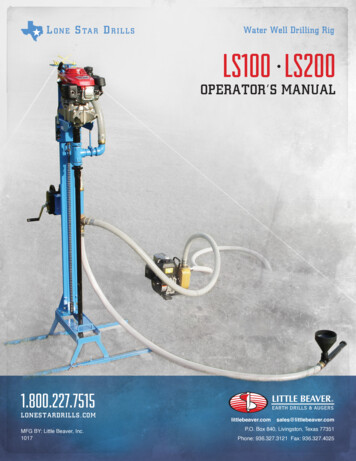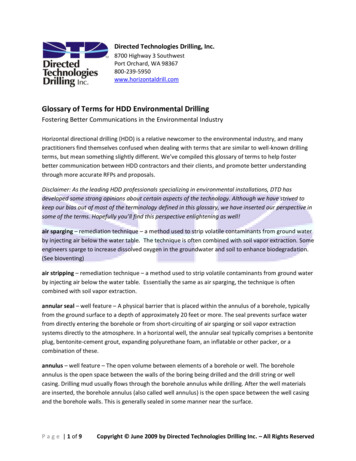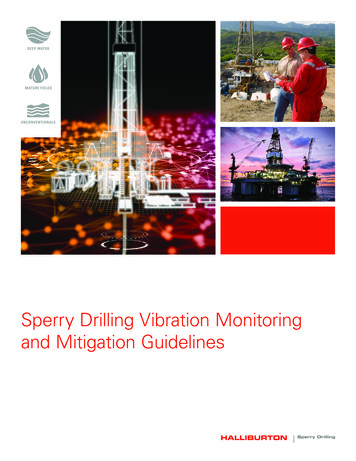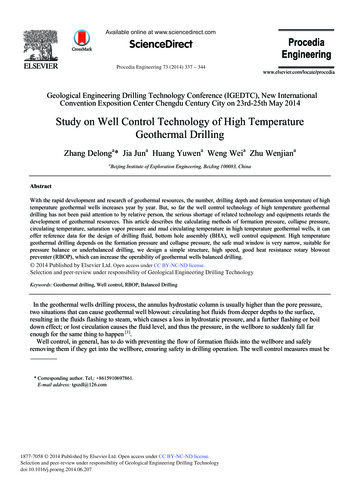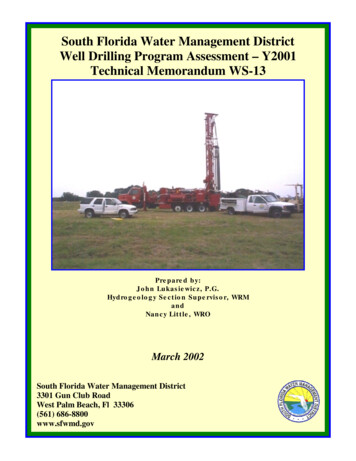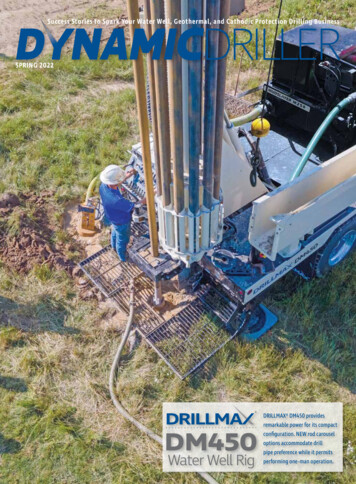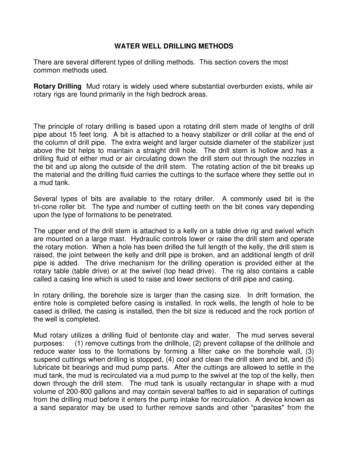
Transcription
WATER WELL DRILLING METHODSThere are several different types of drilling methods. This section covers the mostcommon methods used.Rotary Drilling Mud rotary is widely used where substantial overburden exists, while airrotary rigs are found primarily in the high bedrock areas.The principle of rotary drilling is based upon a rotating drill stem made of lengths of drillpipe about 15 feet long. A bit is attached to a heavy stabilizer or drill collar at the end ofthe column of drill pipe. The extra weight and larger outside diameter of the stabilizer justabove the bit helps to maintain a straight drill hole. The drill stem is hollow and has adrilling fluid of either mud or air circulating down the drill stem out through the nozzles inthe bit and up along the outside of the drill stem. The rotating action of the bit breaks upthe material and the drilling fluid carries the cuttings to the surface where they settle out ina mud tank.Several types of bits are available to the rotary driller. A commonly used bit is thetri-cone roller bit. The type and number of cutting teeth on the bit cones vary dependingupon the type of formations to be penetrated.The upper end of the drill stem is attached to a kelly on a table drive rig and swivel whichare mounted on a large mast. Hydraulic controls lower or raise the drill stem and operatethe rotary motion. When a hole has been drilled the full length of the kelly, the drill stem israised, the joint between the kelly and drill pipe is broken, and an additional length of drillpipe is added. The drive mechanism for the drilling operation is provided either at therotary table (table drive) or at the swivel (top head drive). The rig also contains a cablecalled a casing line which is used to raise and lower sections of drill pipe and casing.In rotary drilling, the borehole size is larger than the casing size. In drift formation, theentire hole is completed before casing is installed. In rock wells, the length of hole to becased is drilled, the casing is installed, then the bit size is reduced and the rock portion ofthe well is completed.Mud rotary utilizes a drilling fluid of bentonite clay and water. The mud serves severalpurposes:(1) remove cuttings from the drillhole, (2) prevent collapse of the drillhole andreduce water loss to the formations by forming a filter cake on the borehole wall, (3)suspend cuttings when drilling is stopped, (4) cool and clean the drill stem and bit, and (5)lubricate bit bearings and mud pump parts. After the cuttings are allowed to settle in themud tank, the mud is recirculated via a mud pump to the swivel at the top of the kelly, thendown through the drill stem. The mud tank is usually rectangular in shape with a mudvolume of 200-800 gallons and may contain several baffles to aid in separation of cuttingsfrom the drilling mud before it enters the pump intake for recirculation. A device known asa sand separator may be used to further remove sands and other "parasites" from the
drilling mud. Samples of cuttings may be obtained directly from the borehole before thefluid and cuttings spill into the mud tank.Most larger rotary rigs have an air compressor to enable the contractor to also use air asthe drilling fluid. The high velocity of the air as it exits the bit is sufficient to blow thecuttings away from the bit and carry them up to the surface where they settle out aroundthe borehole. Air rotary is used primarily for drilling in consolidated (rock) formations. Inrock wells with substantial overburden, mud will be used for drilling through the drift, andafter the casing is set the drilling operation will be converted to air rotary for completion ofthe rock portion of the well. Clean water is often used for drilling the rock portion of thehole after setting the casing.Air hammer drilling, sometimes referred to as down hole drilling, is used extensively inhard rock areas. The bit used in this drilling method is essentially a pneumatic hammeroperated at the end of the drill stem. Compressed air operates a piston which strikesthe top of the bit at a very rapid rate. The cutting tips on the bit are made oftungsten-carbide which are extremely resistant to abrasion. The combined hammeringand rotation of the bit results in penetration of hard rock at a rate faster than any otherdrilling method.Reverse-circulation is another form of rotary drilling. It differs from conventional hydraulicrotary in that the drilling fluid travels in the opposite direction. The drilling fluid travels upthe inside of the drill stem with cuttings, through the pump and is discharged into thesettling pond or tank. After cuttings are settled, the drilling fluid flows into the borehole anddown to the bit. The pressure of the fluid against the bore hole wall prevents caving. Thefew reverse-circulation drilling rigs are used primarily for drilling large diametermunicipal, industrial, and irrigation wells.Cable Tool DrillingCable tool drilling, also known as percussion drilling or spudding, is a widely used welldrilling method. Some rigs are combination rotary-cable tool, enabling the operator touse the rotary along with the casing driving ability of the cable tool. Although it is aslower drilling method, the cable tool is less costly and simpler to operate than a rotary drillrig and is suitable for most geologic conditions.The cable tool operates by raising and dropping a heavy drill string in the drillhole. The drillstring, with bit on the bottom and rope socket (or swivel socket) on top, is suspended in thehole with a cable. The cable is threaded over the crown sheave located at the top of themast, down to the walking beam, and onto the cable drum where it is stored. The up-anddown drilling action imparted to the drill stem and cable by the walking beam. The walkingbeam is pivoted at one end, has a cable sheave at the other end and is connected to thecrank gear with a pitman. Rotation of the crank gear causes the walking beam to move upand down. Additional cables called sand lines or casing lines are used to raise and lowercasing, bailers, plungers, or other tools.
The rhythmic raising and dropping of the bit loosens up sand or clay and breaks up rockinto "cuttings" and mixes them with water added by the driller to form a slurry. The cuttingsare then removed from the hole with a dart-valve bailer or other type of bailing device.Formation type is determined by visual inspection of cuttings from the bailer and the drillingcontractor's knowledge of the rig's operation, such as the difficulty or ease of drilling theparticular formation. The up-and-down motion combined with the left-lay cable and ropesocket cause the drill stem and bit to rotate slightly on each vertical stroke. This rotationhelps maintain drillhole roundness.The portion of the drillhole above the bedrock must be cased to prevent caving. Casing isdriven into the drillhole with the use of heavy drive clamps bolted onto the drill stem. Thedrill stem is lowered into the casing until the drive clamps strike the top of the casing. Theraising and dropping of the heavy drive clamps and drill stem drives the casing into thedrillhole. Prior to driving, a drive shoe of hardened, tempered steel is attached to thebottom of the first length of casing to protect it from damage. The upper end of the casingis protected by inserting a temporary drive cap. The usual cable tool drilling operationinvolves drilling past the end of the casing, bailing the hole to remove cuttings, drivingcasing, cleaning the hole, then resuming drilling. Generally, a few feet of open hole isdrilled beyond the casing before casing is driven. The driving, drilling, and bailingoperations are repeated until the desired depth is reached.In screened wells, the pull-back method is generally used. This involves driving casing tothe bottom of the portion to be screened. A screen of smaller diameter than the casing isplaced into the casing. The top end of the screen is fitted with a K-packer or other devicewhich seals between the screen and casing. The screen is pushed to the bottom of thecasing, then the casing is "bumped" up to expose the screen to the formation. The baileris then used to begin development of the screen.Auger DrillingContinuous-flight, spiral auger well drilling rigs are found where sand is the predominantglacial drift material. In some areas, augers are used to drill the upper portion of the welland then the well is completed with the cable tool method. In other areas, augers areused to drill the entire well.The auger method utilizes spiral augers, usually in 5 foot lengths. The auger stem isturned by a hydraulically-controlled rotary drive head. After drilling the length of an auger,the auger joint is broken and another 5 foot section is added. Cuttings spiral their way upto the surface where they appear around the borehole, making formation identificationrelatively simple. If enough clay is present in the formation, the drillhole will remain openwhen augers are removed. Dry sands and other caving formations may be a problem forthe auger driller and will occasionally result in the loss of long flights of augers. When theauger encounters saturated sand (the water bearing formation to be screened), drillinggenerally can be continued for a short distance but the hole will not remain open in thesaturated formation when the augers are removed. The auger flight is then broken down
and removed from the drillhole after drilling the depth of the well or when changing toanother type of drilling operation.Casing is then placed into the drillhole. Some driving of the casing may be necessarybecause of caving of portions of the drillhole or lack of straightness of the drilled hole. Adrillable plug is generally placed in the end of the casing prior to placement in the drillhole.After placement of the casing, it is then filled with water and the screen driven out throughthe plug and exposed to the water bearing formation. Keeping the casing filled with waterprevents heaving of sand into the casing when the plug is knocked out. Another methodused by some drillers (but not recommended) is to thread the screen directly to the wellcasing, thereby installing the screen and casing in one operation. The well is than pumpedto remove the fine material from around the screen and to determine if water quality andquantity are suitable.Hand DrivingDriven wells are common in many areas, especially around lakes wheregroundwater may be close to the surface. Simple installation methods and the low cost ofmaterials make them attractive to homeowners or cottage owners who wish to install theirown water supplies. However, since the well point and casing are driven into the ground,soil conditions are a major factor in suitability of the site. The site must be generally sandyand free of boulders or bedrock to be suitable for a driven well. Hard clay, silt, and veryfine sand are generally difficult to drive through.The installation of a driven well often begins by augering a hole with a hand auger orposthole digger as far as possible. A drive point, consisting of a reinforced well screen witha steel point on the end, is coupled to a 5 foot length of galvanized casing. The mostcommon casing size for driven wells is 1-1/4 inch inside diameter. A drive cap is placed anthe top of the casing and a heavy weight is used to strike the top of the drive cap, drivingthe point into the ground, When the drive cap is driven close to the ground and drivingcannot be continued, another length of casing is added and driving is resumed. Specialdrive couplings are used to join sections of casing,Hand driving is usually accomplished by using a weighted driver consisting of a 3 or4foot piece of 3 inch diameter pipe capped on the top end. Extra weight is placed in the topportion of the driver. The driver fits over the casing and is guided by it. Another type ofdriver has a steel rod on the bottom that slides into the casing through a hole in the drivecap. Raising and dropping the driver is done with the use of handles welded on the sidesof the driver. The weighted driver may also be suspended from a tripod and tacklearrangement. The use of a sledge hammer for driving is not recommended since it mayresult in bent or broken casing from glancing blows.As driving progresses, penetration becomes increasingly difficult due to friction betweenthe drive point/casing and the soil. Depths beyond 40 feet become difficult when driving byhand. Driving a well is always a gamble since a boulder can easily damage the well pointor completely stop the driving. When a driven well attempt is aborted, the casing and well
point must often be left in the ground since retrieval is difficult without additionalequipment.A weighted string is used periodically during driving to determine if water has beenencountered. When water has been reached, the string will come up wet. The well screenmust then be developed to remove the fine material. This is accomplished by pumpingand surging. A pitcher pump or shallow well jet pump may be used for development.Pumping and/or surging is continued until the water, which at first is full of sand and silt,runs clear. If an auger was used to start the hole, it is necessary to grout the annularspace between the drillhole and casing. Bentonite or neat cement may be used for thispurpose.The major disadvantages of driven wells are as follows: (1) they are generally shallow,therefore more vulnerable to surface or near surface contamination; (2) the screens tend toencrust with carbonates at a faster rate due to their small diameter; and (3) their yield islimited ( 10 gallons per minute [gpm]), since they can be pumped only with a shallow welljet pump or hand pump.JettingJetting is a drilling method suited for the sandy areas. Jetting remains a popularmethod for drilling small diameter wells due to its simplicity and inexpensive costof equipment. Many of the portable, do-it-yourself drilling machines advertised inmagazines utilize the jetting method.Jetting and hollow-rod equipment are quite similar except that drilling water is pumped withthe jetting method and the direction of water flow is opposite. The jetting method involvesusing a high velocity stream of water to break up the formation material and wash thecuttings away. A chisel-shaped bit with holes to serve as nozzles is attached to the end ofa string of hollow drill pipe. Water pressure is provided to the nozzles by using a highpressure pump. Water exits from the nozzles and loosens the material being drilled whilekeeping the bit clean. The bit is raised and lowered and rotated slightly to maintain around hole. The cuttings are washed to the surface on the outside of the drill pipe and flowinto a settling pit or tank. Cutting samples are easily obtained at this point. A 55 gallondrum is often used for this purpose. After cuttings are allowed to settle, the water isrecirculated through the pump, swivel, drill pipe and down to the bit. Jetting can also bedone without recirculation of the drilling water; however, a continuous supply of water mustbe available at the site.The casing is usually installed as the drilling proceeds. A drive shoe is attached to thebottom end of the casing and a drive cap inserted in the top. A drive block clamped to thedrill pipe is used to force the casing into the drill hole. The depth of the open hole drilledbefore casing is installed depends on the type of formation and whether bentonite hasbeen added to the water as a drilling fluid to keep the hole open. The drilling/drivingsequence is extremely time consuming in caving formations, especially at greater depths,since the drill string must be disassembled and removed from the well before drivingcasing and must be reassembled before resuming drilling.
Hollow-Rod DrillingHollow-rod is sometimes referred to as the hydraulic-percussion drilling method. Thehollow-rod is an old drilling method that can be time consuming in some situations, butMostremains popular due to its simplicity and relatively low cost of equipment.hollow-rod wells are 2 inch diameter, but 4 inch casings are installed occasionally. Thismethod is well suited for sand and soft clay formations with relatively few boulders. Itcan also be used for drilling rock wells, but progress is slowed considerably. Wellsseveral hundred feet in depth have been completed by the hollow-rod method.The drill string used in hollow-rod drilling is similar to that used in jetting, except that thechisel bit has a ball check valve in it. Water or a clay-water mixture is kept in the annularspace between the drill rods and well casing to help prevent the uncased portion of thehole from collapsing. The water is supplied to the annulus by gravity intake from a smallmud tank. A 55 gallon drum is often used as a settling tank.Drilling is done by lifting and dropping the drill stem and bit. The drill pipe used has triplewall thickness to add weight to the drill string. The drill string is also rotated slightly byhand during each stroke to maintain a round drill hole. As the bit drops, the ball checkopens and mud and cuttings enter the hollow drill rods. On the upstroke, the check valvecloses and keeps the cuttings in the drill rods.Eventually the drill rods fill up and the slurry is discharged into the mud tank at the surfacewhere the cuttings settle out. Samples of cuttings can easily be obtained from the mudtank. The continuous reciprocating drilling motion maintains circulation of the drilling fluidfrom the bit, up the drill rods to the mud tank, from the mud tank into the annulus, anddown to the bit. The direction of flow is opposite that in the jetting operation and nopressure pump is required.Casing is driven as drilling progresses by clamping a weighted drive block to the drill rods.When another length of casing is added, the drill rods must be disassembled and removedfrom the hole. The drill rods are then reassembled, casing is driven, the drive block isremoved and drilling is resumed.Close observation of formation samples andwater/drilling fluid circulation by the drilling contractor is essential to determine whengroundwater has been encountered. When a water-bearing strata is reached, drilling fluidis usually lost to the formation. At this point, it is necessary to install a well screen, if in anunconsolidated formation, and begin the well development process. Hollow-rod rigs areequipped with walking beams, thus a plunger is most generally used to develop the well.
OTHER DRILLING METHODSDownhole HammerUse of the down hole air hammer with rotary equipment provides a combined percussionrotary method that penetrates rapidly in consolidated formations. Test holes are usually 6inches in diameter when using this method. In most cases, however, conventional waterbased drilling fluids must be used with a roller bit when drilling through unconsolidatedoverburden above bedrock. Exceptions to this occur when an air hammer is used to drivethe casing after materials are blown out of the casing or when the rig is equipped with acasing driver.This method allows contractors to drill more wells, and be able to drill them deeper andfaster. Instead of using a mud pump, they use compressed air.Dual Tube RotaryIn this method, the drill pipe and bit are joined and advanced simultaneously. Theconventional top drive drills the open hole and the lower rotary drive is used to set casingwithout any requirement for casing hammers, under-reamers, or drilling mud. Advantagesof this drilling method are: ability to drill in tough conditions, quicker penetration rates,straighter holes, and a large compressor is not needed because the lower drive operateson hydraulics.Either air or water can be used as the drilling fluid in this modification of reverse circulationtechnique. There is usually no grinding of cuttings, and the drilling fluid, if not air, can beclear water.SonicA sonic drill uses high frequency mechanical oscillations, developed in the special drillhead, to transmit resonant vibrations and rotary power through the drill tooling to the drillbit. The operator controls the frequencies to suit the specific conditions of the geology. Anair spring in the drillhead isolates the vibrations from the rest of the rig. The vibrationsfluidize the soil particles at the bit face, allowing fast and easy penetration in mostgeological formations including bolders and rock.One of the main advantages of the sonic drill is its ability to produce continuous coresamples of both unconsolidated and consolidated formations with detail and accuracy. Thecore samples can be analyzed to provide a precise and detailed stratigraphic profile of anyoverburden condition including dry or wet saturated sands and gravels, cobbles andboulders, clays, silts and hard tills.Directional DrillingDirectional drilling is the technique of drilling at an angle from the vertical by deflecting thedrill bit. Directional wells are drilled for a number of reasons: to develop and offshore leasefrom one drilling platform; to reach a payzone beneath land where drilling cannot be done,e.g., beneath a railroad, cemetery or lake, or to drill around a blockage in an existingwellbore. A pilot hole is drilled under the natural feature and then backreamed to make thehole large enough to accommodate the pipe. Once the hole is large enough the pipe ispulled through the hole.
COMPARISON OF WATER WELL DRILLING METHODSCable ToolRotaryAugerHollow RodJettingDrivingOther namesPercussionSpuddingChurn DrillHydraulic rotary(mud roatary, airrotary, downhole hammer,reversecirculation)Continuousflight augerHydraulicpercussionJet-percussionDriven wellpoint, stab wellDrilling motionRaisingdropping of drillstem and bitRotating drillstring and bitRotating ofaugers and bitRaisingdropping of drillrods and bitJetting action ofwater exiting bitDrill stringCable withsuspended drillstring (ropesocket, drillstem, bit)As drillingproceedsSwivel-kelly drillrods-stabilizerbit (top head ortable drive)Top head driveauger flights-bitSwivel-driveblock drill rodsbitSwivel-driveblock drill rodsbitWell point andcasing driveninto ground todisplace soilmaterialDrive cap-5 footcasing lengthsdrive pointAfter drillhole iscompleteAfter drillhole iscompleteAs drillingproceedsAs drillingproceedsAs ty (somedriving)Gravity (somedriving)DrivenDrivenDrivenDrilling fluid typeWaterDown annulusup drill rodsDown drill rodsup annulusDirection of fluidflowStationaryDown annulusup drill rodsDown drill rodsup annulusRetrieval ofcuttingsBailerBentonite water(mud roatary),air (air rotary ordown holehammer), water(rev. rotary)Down drill rodsup annulus(oppositve inrev. rotary)Flow into mudpit with drillingfluidFlow into mudpit with drillingfluidFlow into mudpit with drillingfluidCasinginstallationDeposited onground surface
ADVANTAGES & DISADVANTAGES OF COMMON DRILLING METHODSDrilling Method AdvantagesCable ToolInexpensive Equipment:1/5 cost of rotary rig, less groutingequipment needed, large watertruck unnecessary, lower fuelconsumption, lower operating cost.Limited Tooling Required:Bits can be resurfaced, lessexpensive tooling, used itemsreadily available.Less Material Removed DuringDrilling:Generally no oversized borehole,material removed from casinginside diameter, lighter soils can bebailed from casing.Repair Work:Cable tool rigs ideal for casingreaming, screen replacement, anddevelopment.Jetting andInexpensive Equipment:Hollow Rod1/5 cost of rotary rig, less groutingequipment needed, large watertruck unnecessary, lower fuelconsumption, lower operating cost.Limited Tooling Required:Bits can be resurfaced, lessexpensive tooling, used itemsreadily available, many toolsrefabricated.Less Material Removed DuringDrilling:Generally no oversized borehole,material removed from casinginside diameter.Repair Work:Jetting rigs ideal screenreplacement and development.DisadvantagesSlow Drilling Speed:Bedrock drilling – 1/7 as fast asrotary drilling, Glacial drift drilling –1/5 as fast as rotary drillingDepth Limitations with SingleCasing String:Driving generally difficult in cavingformations, ability to drive casing islimited by tool weight and groundfriction.Outer Casing Needed for GravelPacking or Full Length Grouting:3 to 4 inch larger casing needed tomaintain annulus and must beextracted during grouting.Steel Casing Material Only:PVC casing can not be usedunless installed in an oversizedborehole without driving.Slow Drilling Speed:Bedrock drilling – uncommon,requires heavy drill bar, 1/7 as fastas rotary drilling, Glacial drift drilling– 1/5 as fast as rotary drilling,limited use in gravel formations.Depth Limitations with SingleCasing String:Driving generally difficult in cavingformations, ability to drive casing islimited by tool weight and groundfriction.Outer Casing Needed for GravelPacking or Full Length Grouting:3 to 4 inch larger casing needed tomaintain annulus and must beextracted during grouting.Steel Casing Material Only:PVC casing can not be usedunless installed in an oversizedborehole without driving.
RotaryAuger (SolidStem andHollow Stem)Speed of Drilling:5 to 7 times faster than cable tool,capable of several hundred feetper day (dependent on geologicmaterial).Options of Well Design:Screen can be telescoped orattached, separate screens can beinstalled, filter packing to enhanceformation production, downhollecasing hammer method.Grouting:Oversized borehole requiresgrouting of annular spacesurrounding casing, mostadaptable to various groutplacement methods, practical forgrout placement thru casing.Speed of Drilling:Fast for shallow holes withoutcobbles or gravel and with lowwater table, auger/cable tool orjetting combination rigs arecommonLimited Equipment:Less expensive than rotary,minimal amount of equipmentneeded.Cost of Equipment:5 times as costly as a cable tool orjetting rig, bit cost and tooling moreexpensive.Maintenance & Support:Much more extensive and costlythan cable tool, higher fuelconsumption, water truck needed.Limited Depth:Poor results in caving formations,gravel, or high water table, lessthan 100 feet.
WATER WELL COMPONENTSThis section covers the major water well components used when installing a water well.BoreholeBorehole is a vertical boring to reach aquifer (water bearing geologic material). In a wellterminating into rock, an open borehole will extend beyond the bottom of the well casing.Well SealWell seal is a mechanical device to prevent contamination from entering well casing that isinstalled after well completion. All well caps and seals shall be weathertight, tightlysecured, and vermin proof.CasingWell casing is steel or plastic pipe installed to keep borehole wall from collapsing andhouses the submersible pump and drop pipe.Comparison of PVC plastic casing and steel casing:PVCvs.SteelNoncorrodingCorrodesLower strengthHigher strengthFewer water quality complaintsRusty waterRotary construction onlySuitable for any drilling methodGroutGrout is impermeable cement or clay placed in annular space between borehole andcasing to prevent well contamination, maintain separation of aquifers, and preserveartesian aquifers.Filter packFilter pack is silica sand often placed around the outside of the screen for filtration andstabilization. The main objective to filter packing is to install a material more permeablethan the native formation into the area immediately surrounding the well screen. Filterpack not only prevents fine sands from entering the well screen, it also stabilizes theborehole.The benefits of filter packing are: Greater porosity Higher hydraulic conductivity Reduced drawdown Higher yield Reduced entrance velocity Faster development Easier grouting Longer well life Improved well rehabilitation
Reduced sand pumpingPackerA neoprene packer (often called a K packer) is a device that seals space between casingand telescoped screen to keep sand out of well. The packer is attached directly to eitherthe top of the well screen or the top of a riser pipe. Lead packers are no longer allowed insome states.ScreenA well screen is a filtering device that serves as the intake portion of wells constructed inunconsolidated or semiconsolidated aquifers. A screen permits water to enter the wellfrom the saturated aquifer, prevents sediment form entering the well, and servesstructurally to support the unconsolidated aquifer material.Slot openings have been designated by numbers that correspond to the width of theopenings in thousandths of an inch. A No.10 slot, for example, is an opening of O.010inch. Slot size may also be expressed in metric units; for example, 0.010 inch equals 0.25millimeter (mm). For small-diameter screens covered with wire mesh, the number ofopenings in the mesh per inch are designated by gauze numbers.GeologicalMaterialClay & SiltFine sandMedium sandCoarse sandVery coarse sandVery fine gravelFine gravelSlot .0350.0500.0900.1500.2500.375Opening (mm)Gauze 272.293.816.359.529080706050403020-When selecting the proper screen to install, the following selection criteria need to beconsidered: Maximize the percent of open area. Nonclogging openings. Corrosive resistance. Column and collapse strength.
Screen opening (slot size) based on aquifer material.Screen diameter that provides a water entrance velocity of less than .1 foot/second.Fact or Fiction? – “Doubling the well diameter appreciably increases well yield.”AnswerDoubling the well diameter increases the well yield only 10 percent.Doubling the screen length increases the well yield 100 percent.
TYPICAL WELL CROSS SECTIONNOTE: If the well terminated into bedrock, the packer, filter pack,and screen would not be present, and an openborehole would extend below the casing.Well SealBoreholeCasingGroutPackerScreenFilter pack
TYPES
the rock portion of the well. Clean water is often used for drilling the rock portion of the hole after setting the casing. Air hammer drilling, sometimes referred to as down hole drilling, ised extensively in us hard rock areas. The bit used in this drilling method is essentially a pneumatic hammer operated at the end of the drill stem.
